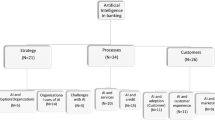Abstract
Credit scoring methods for predicting creditworthiness have proven very effective in consumer finance. In light of the present financial crisis, such methods will become even more important. One of the outstanding issues in credit risk classification is population drift. This term refers to changes occurring in the population due to unexpected changes in economic conditions and other factors. In this paper, we propose a novel methodology for the classification of credit applications that has the potential to adapt to population drift as it occurs. This provides the opportunity to update the credit risk classifier as new labelled data arrives. Assorted experimental results suggest that the proposed method has the potential to yield significant performance improvement over standard approaches, without sacrificing the classifier's descriptive capabilities.





Similar content being viewed by others
References
Adams NM, Tasoulis DK, Anagnostopoulos C and Hand DJ (2010). Temporally-adaptive linear classification for handling population drift in credit scoring. In: Lechevalier Y (ed). Proceedings of COMPSTAT2010: 19th International Conference on Computational Statistics. Springer: Berlin Heidelberg, pp 167–176.
Anagnostopoulos C, Tasoulis DK, Adams NM and Hand DJ (2010). Temporally adaptive estimation of logistic classifiers on data streams. Advances in Data Analysis and Classification 3 (3): 243–261.
Anderson JA (1982). Logistic discrimination. In: Krishnaiah P and Kanal L (eds). Handbook of Statistics 2, pp 169–191.
Baesens B, Gestel TV, Viaene S, Stepanova M, Suykens J and Vanthienen J (2003). Benchmarking state-of-the-art classification algorithms for credit scoring. Journal of the Operational Research Society 54 (6): 627–635.
Benveniste A, Métivier M and Priouret P (1990). Adaptive Algorithms and Stochastic Approximation. Springer-Verlag: New York.
Hand DJ (2005). Good practice in retail credit scorecard assessment. Journal of the Operational Research Society 56 (9): 1109–1117.
Hand DJ (2009). Measuring classifier performance: A coherent alternative to the area under the ROC curve. Machine Learning 77 (1): 103–123.
Hand DJ and Henley WE (1997). Statistical classification methods in consumer credit scoring: A review. Journal of the Royal Statistical Society Series A 160 (3): 523–541.
Hand DJ and Kelly MG (2001). Lookahead scorecards for new fixed term credit products. Journal of the Operational Research Society 52 (9): 989–996.
Haykin S (2001). Adaptive Filter Theory, 4th edn. Prentice-Hall: Upper Saddle River, NJ.
Igel C and Hüsken M (2003). Empirical evaluation of the improved Rprop learning algorithms. Neurocomputing 50: 105–123.
Kelly MG, Hand DJ and Adams NM (1999). The impact of changing populations on classifier performance. In: Chaudhuri S and Madigan D (eds). Proceedings of the 5th ACM SIGKDD International Conference on Knowledge Discovery and Data Mining. AAAI Press: San Diego, CA, pp 367–371.
Krzanowski WJ and Hand DJ (2009). ROC Curves for Continuous Data. CRC/Chapman and Hall: Boca Raton, FL.
Lucas A (1992). Updating scorecards: Removing the mystique. In: Thomas L, Crook J and Edelman D (eds). Credit Scoring and Credit Control. Clarendon: Oxford, pp 180–197.
Pavlidis NG, Tasoulis DK, Adams NM and Hand DJ (2011). λ-perceptron: An adaptive classifier for data-streams. Pattern Recognition 44 (1): 78–96.
Thomas LC (2009). Consumer finance: Challenges for operational research. Journal of the Operational Research Society 61: 41–52.
Whittaker J, Whitehead C and Somers M (2007). A dynamic scorecard for monitoring baseline performance with application to tracking a mortgage portfolio. Journal of the Operational Research Society 58 (7): 911–921.
Acknowledgements
We wish to thank the editor and two anonymous referees for their valuable comments and suggestions which greatly improved this paper. This research was undertaken as part of the ALADDIN (Autonomous Learning Agents for Decentralised Data and Information Networks) project and is jointly funded by a BAE Systems and EPSRC (Engineering and Physical Research Council) strategic partnership, under EPSRC grant EP/C548051/1. David J. Hand was partially supported by a Royal Society Wolfson Research Merit Award. We are grateful to the UK bank that provided the data.
Author information
Authors and Affiliations
Corresponding author
Rights and permissions
About this article
Cite this article
Pavlidis, N., Tasoulis, D., Adams, N. et al. Adaptive consumer credit classification. J Oper Res Soc 63, 1645–1654 (2012). https://doi.org/10.1057/jors.2012.15
Received:
Accepted:
Published:
Issue Date:
DOI: https://doi.org/10.1057/jors.2012.15




